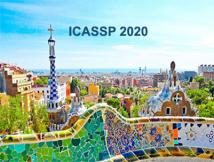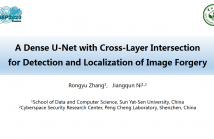
ICASSP is the world’s largest and most comprehensive technical conference focused on signal processing and its applications. The ICASSP 2020 conference will feature world-class presentations by internationally renowned speakers, cutting-edge session topics and provide a fantastic opportunity to network with like-minded professionals from around the world. Visit website.

- Read more about ANALYSIS OF ACOUSTIC FEATURES FOR SPEECH SOUND BASED CLASSIFICATION OF ASTHMATIC AND HEALTHY SUBJECTS
- Log in to post comments
Non-speech sounds (cough, wheeze) are typically known to perform better than speech sounds for asthmatic and healthy subject
classification. In this work, we use sustained phonations of speech sounds, namely, /A:/, /i:/, /u:/, /eI/, /oU/, /s/, and /z/ from 47 asthmatic and 48 healthy controls. We consider INTERSPEECH 2013 Computational Paralinguistics Challenge baseline (ISCB)
- Categories:
 40 Views
40 Views
- Read more about CONFIRMNET: CONVOLUTIONAL FIRMNET AND APPLICATION TO IMAGE DENOISING AND INPAINTING
- Log in to post comments
- Categories:
 35 Views
35 Views
- Read more about TOWARDS FAST AND ACCURATE STREAMING END-TO-END ASR
- Log in to post comments
- Categories:
 23 Views
23 Views
- Read more about CONSENSUS-BASED DISTRIBUTED CLUSTERING FOR IOT
- Log in to post comments
Clustering is a common technique for statistical data analysis and it has been widely used in many fields. When the data is collected via a distributed network or distributedly stored, data analysis algorithms have to be designed in a distributed fashion. This paper investigates data clustering with distributed data. Facing the distributed network challenges including data volume, communication latency, and information security, we here propose a distributed clustering algorithm where each IoT device may have data from multiple clusters.
- Categories:
 48 Views
48 Views
- Read more about CLCNet: Deep learning-based noise reduction for hearing aids using Complex Linear Coding
- Log in to post comments
Noise reduction is an important part of modern hearing aids and is included in most commercially available devices. Deep learning-based state-of-the-art algorithms, however, either do not consider real-time and frequency resolution constrains or result in poor quality under very noisy conditions.To improve monaural speech enhancement in noisy environments, we propose CLCNet, a framework based on complex valued linear coding. First, we define complex linear coding (CLC) motivated by linear predictive coding (LPC) that is applied in the complex frequency domain.
- Categories:
 40 Views
40 Views
- Read more about A DENSE U-NET WITH CROSS LAYER INTERSECTION FOR DETECTION AND LOCALIZATION OF IMAGE FORGERY
- Log in to post comments
In this paper, we apply cross-layer intersection mechanism to dense u-net for image forgery detection and localization. We first train DenseNet for binary classification. Spatial rich model (SRM) filters are adopted for capturing residual signals in the detected images. Then we propose a new approach to preserve complete feature maps of fully connected layer and consider them as the spatial decision information for image segmentation.
- Categories:
 64 Views
64 Views
Arrays of closely-spaced antennas with mutual coupling have been considered recently with analogies to the hearing mechanism in small insects that exhibit excellent direction finding capabilities. We develop a model for a two-element array system that includes three distinct noise sources and a 4-port electrical network that couples the antennas to the measurement loads. The optimum coupling network that minimizes the Cramer-Rao bound (CRB) for angle of arrival (AOA) estimation is derived and a design method is presented to synthesize the network.
- Categories:
 19 Views
19 Views
- Read more about SeCoST: Sequential Co-Supervision For Large Scale Weakly Labeled Audio Event Detection
- Log in to post comments
Weakly supervised learning algorithms are critical for scaling audio event detection to several hundreds of sound categories. Such learning models should not only disambiguate sound events efficiently with minimal class-specific annotation but also be robust to label noise, which is more apparent with weak labels instead of strong annotations. In this work, we propose a new framework for designing learning models with weak supervision by bridging ideas from sequential learning and knowledge distillation.
- Categories:
 8 Views
8 Views
- Read more about SEQUENTIAL DEEP UNROLLING WITH FLOW PRIORS FOR ROBUST VIDEO DERAINING
- Log in to post comments
Video deraining has attracted wide attention since the urgent
demand of high-quality video in recent years. The indistinct
details and nonideal deraining effects are the most common
defects in existing techniques, whose cause lies in the insufficient
usage of single-frame image and temporal information.
To effectively settle video deraining, we establish a new deraining
model with flow priors to simultaneously introduce
spatial and temporal information for accurately depicting the
enhancement model of the current frame. A sequential deep
ICASSP.pdf
- Categories:
 29 Views
29 Views
- Read more about MULTI-RESOLUTION MULTI-HEAD ATTENTION IN DEEP SPEAKER EMBEDDING
- 1 comment
- Log in to post comments
It is related to this paper: https://ieeexplore.ieee.org/document/9053217.
- Categories:
 59 Views
59 Views